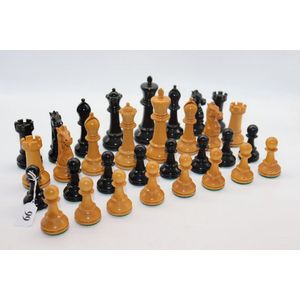Premium Chess Set with Masonic Decoration
Staunton original master chess set, the Craftsman artisan golden castle chess set, Staunton pattern chessmen made in Japan, hand crafted and carved finest quality in original oak box with applied enamel masonic decoration
You must be a subscriber, and be logged in to view price and dealer details.
Subscribe Now to view actual auction price for this item
When you subscribe, you have the option of setting the currency in which to display prices to $Au, $US, $NZ or Stg.
This item has been sold, and the description, image and price are for reference purposes only.
- Oak - Native to Europe and England, oak has been used for joinery, furniture and building since the beginning of the medieval civilisation. It is a pale yellow in colour when freshly cut and darkens with age to a mid brown colour.
Oak as a furniture timber was superceded by walnut in the 17th century, and in the 18th century by mahogany,
Semi-fossilised bog oak is black in colour, and is found in peat bogs where the trees have fallen and been preserved from decay by the bog. It is used for jewellery and small carved trinkets.
Pollard oak is taken from an oak that has been regularly pollarded, that is the upper branches have been removed at the top of the trunk, result that new branches would appear, and over time the top would become ball-like. . When harvested and sawn, the timber displays a continuous surface of knotty circles. The timber was scarce and expensive and was used in more expensive pieces of furniture in the Regency and Victorian periods. - Staunton Chess Set - How should the king, queen, rooks and other pieces be depicted? Why is the king always the tallest piece and have a cross on his head. And why is the knight depicted as a horse head?
Until the adaption of a standard design, the designs of the pieces in every set varied. The Staunton chess set set a standard design for each piece used in the game of chess, and was the style adopted for use in chess competitions.
The Staunton designs were developed in 1849 and sold by sports and games manufacturers Jaques & Son of London, and were either designed by the proprietor of the firm, John Jaques or his his brother in law, Nathaniel Cook.
The design was named after Howard Staunton, an English chess player who was regarded as the leading player in the 1840s to 1850s.
The style has been popular for more than 160 years, and is still the standard today in tournament chess games and competitions.
This item has been included into following indexes:
